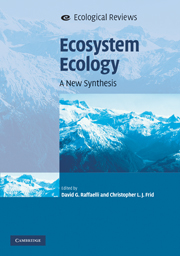Book contents
- Frontmatter
- Contents
- List of contributors
- Preface
- 1 The evolution of ecosystem ecology
- 2 Linking population, community and ecosystem ecology within mainstream ecology
- 3 Thermodynamic approaches to ecosystem behaviour: fundamental principles with case studies from forest succession and management
- 4 Ecosystem health
- 5 Interdisciplinarity in ecosystems research: developing social robustness in environmental science
- 6 The links between biodiversity, ecosystem services and human well-being
- 7 Ecosystem ecology and environmental management
- Index
- References
5 - Interdisciplinarity in ecosystems research: developing social robustness in environmental science
Published online by Cambridge University Press: 05 June 2012
- Frontmatter
- Contents
- List of contributors
- Preface
- 1 The evolution of ecosystem ecology
- 2 Linking population, community and ecosystem ecology within mainstream ecology
- 3 Thermodynamic approaches to ecosystem behaviour: fundamental principles with case studies from forest succession and management
- 4 Ecosystem health
- 5 Interdisciplinarity in ecosystems research: developing social robustness in environmental science
- 6 The links between biodiversity, ecosystem services and human well-being
- 7 Ecosystem ecology and environmental management
- Index
- References
Summary
Introduction
Within the academic community, there is a strong rhetorical value surrounding the idea of interdisciplinarity in research and teaching, but, as is often the case, that rhetoric about the benefits of collaboration outpaces developments in practice (Huber 1992). It is not that research which crosses disciplinary boundaries does not exist; interdisciplinary subgroups and research centres abound in academic institutions. Research councils, likewise, are progressively making interdisciplinarity more and more part of the core criteria by which funding is allocated to the research community. However, despite flurries of activity, the reality of engagement can be less satisfying and achieve less than initially envisioned (Pickett et al. 1999, Tress et al. 2005, Raffaelli and Frid this volume). Yet, the urgent need to better understand the complex environmental problems facing society and the imperative to find solutions to these problems remain and continue to compel the development of interdisciplinary innovation in environmental studies.
In this chapter we explore the development, promises and challenges of research which crosses the boundaries between the ecological, social and economic sciences, and what this means for the development of ecosystems research. We aim to reinforce and give depth to rationales for collaboration as well as arguing for a more ambitious and reflexive approach to interdisciplinarity and, hopefully, to provide impetus for a more meaningful and satisfactory experience for those taking the interdisciplinary road.
- Type
- Chapter
- Information
- Ecosystem EcologyA New Synthesis, pp. 94 - 109Publisher: Cambridge University PressPrint publication year: 2010

